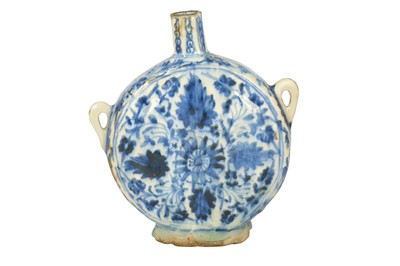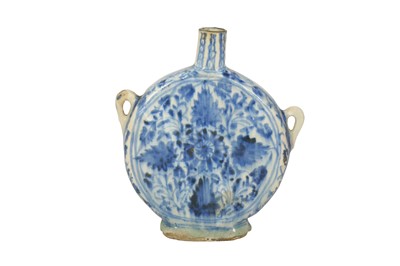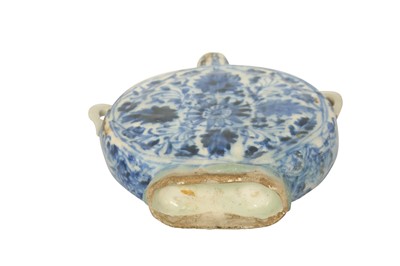16th Apr, 2021 13:00
Islamic & Indian Art
A BLUE AND WHITE POTTERY MOON FLASK
Safavid Iran, 17th century
A BLUE AND WHITE POTTERY MOON FLASK
Safavid Iran, 17th century
Of typical circular shape with flattened sides, resting on a short splayed oval foot, rising to a short cylindrical neck, with a pair of tiny curved handles to the sides, painted in deep cobalt blue against white ground, the fritware body covered with a thick glossy glaze drooping onto the foot, the design, shape and decoration reminiscent of Chinese Ming prototypes and consisting of a central floral medallion surrounded by jagged leaves and interlocking vegetal and floral sprays to the body, stylised cusped arabesques and vegetal trellis to the sides, and stylised dotted bands to the neck, 17.5cm high.
Chinese porcelain moon flasks, also known as bianhu or baoyueping (embracing the moon), were possibly one of the most popular and iconic forms of art pottery ever produced. Their charming rounded shapes with flattened sides and often function-less, decorative handles witnessed a true Golden Age in China during the Ming (1368 - 1644) and Qing (1644 - 1912) dynasties. It is believed that the flattened gourd design was originally inspired by pilgrim flasks, often bearing two handles. Throughout the Middle Ages, these flasks were used for transporting holy water and essences gathered from pilgrimage sanctuaries. The form of Western prototypes available in the Holy Land inspired Islamic craftsmen to introduce this design into the repertoire of Middle Eastern metalwares and it eventually reached China thanks to the intense commercial exchanges taking place along the Silk Road.
Given the Safavid potters' fascination with Chinese blue and white porcelains in the 16th and 17th centuries, it should not surprise that the model of the moon flask was reintroduced in Iran in the 17th century, this time in its pottery rather than metal form. The design, shape and decorative inspiration of this flask are quintessentially rooted in the tradition of Chinese porcelains and may at first hint at a Far Eastern origin. However, the choice of material (fritware), the stylisation of the decorative motifs and, last but not least, the drips of glossy thick glaze by the foot all unequivocably indicate and support an Iranian attribution (O. Watson, Ceramics from Islamic Lands, 2004, pp. 449 - 470).
Do you have an item similar to the item above? If so please click the link below to submit a free online valuation request through our website.




